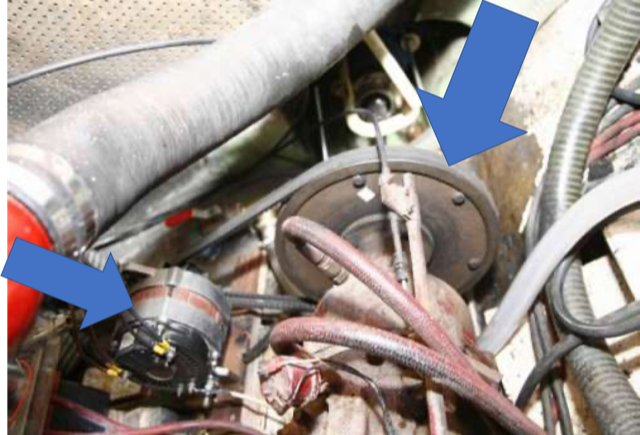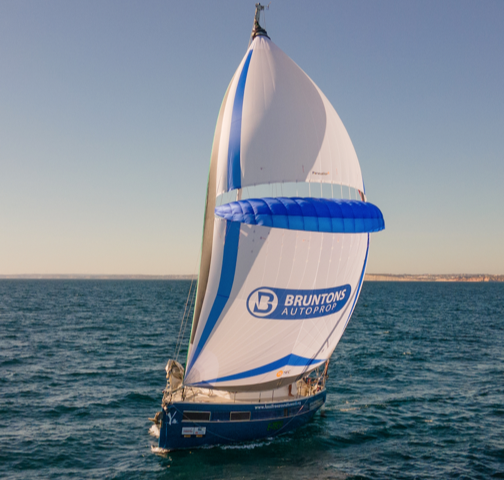Hydro generation covers an essential part of a sailor’s energy need, next to solar panels and wind generation. This third way of supplying stabilizes your energy household. It is like sitting on a tripod instead of a chair with only two legs. When you are sailing and meanwhile the propeller generates electricity, you feel that unexplainable fossil freedom.

Hydro energy is free energy, who does not want that? I tell you: too many sailors.
Hydro energy is safer than a windmill (mostly set too low, so dangerous blades), than a solar panel (can blow away in a storm). Of course, it is also safer than a fossil fuel generator (fire, unhealthy). Who does not want that? Again: too many sailors.
Every cruiser, especially the long-distance cruiser, can get the energy really simple, and for low costs. You just connect an alternator to your propeller and you let it run when you sail. We will explain how.
To start with the result: there will be an alternator in your engine room, driven by a V-belt, which runs over a pully around the propeller shaft. When the propeller runs, it will make the alternator run, generating electricity, and a (built in) rectifier will give the voltage your battery needs (most yachts have 12 Volt).

Balancing RPM, (1) the alternator
The alternator is the most critical thing, so we start here. Most car alternators will start to generate electricity when making 800 rotations per minute (RPM). This so-called cut-in RPM, just tells you it would deliver its first Watt. We want more Watts; practice is to start from 1000 RPM.
If you buy an alternator, check some things:
- The rectifier. For most yacht systems it must be 12 Volt. Then it delivers till 14,5 Volt to load your battery completely.
- How heavy the alternator is. If it charges over 80 Amperes at 12 Volt, then make sure it has a double pulley (and double V-belt)
- Check the diameter of the pulley. It should be rather small; about 50 mm.
Now we go to the next step: how many rotations does the propeller make? Then we can we determine the final step: how many times bigger must the pulley on the propeller shaft be, to get that 1000 RPM?
Balancing RPM (2) the propeller
A propeller will start delivering a constant strong rotation when the boat sails over 4,5 knots. We take some extra and make it 5 knots. (If you are interested in the theory, Betz’s law tells you all about how much speed is needed to make a propeller run, in water, in wind, whatever)
Now comes the fun part.
There are two ways to learn the RPM of your propeller: by measuring it, or by calculation. Best is to try both methods.
First the measuring method.
You set sail and measure the RPMs when you sail e.g. 5 knots. You can buy an expensive RPM meter of 50 Euros or you measure it as follows:
- take a 20 cm line.
- Tape 5 cm of it on your shaft in the engine room
- When your shaft makes rotations, the end of the line will hit the hull skin: TICK
- Take the Dictaphone on your mobile phone
- When your yacht makes 5 knots, push the recording button
- After exactly 1 minute, you stop recording.
- Play the Dictaphone and you see a spike every moment the end of the line makes the TICK
- Count the number of spikes and you have the RPM of your propeller when sailing 5 knots.
Now the calculation method.
The number of rotations depends on the pitch of your propeller. You can read that on the propeller. This says for example: 14” X 16”. The first number: 14” stands for the rotation diameter of 14 inch. The 16” is the pitch. This 16-inch (or 0,4 meter) pitch means, that it will theoretically go 16 inches (0,4 m) forward in one complete rotation.
Suppose you make 5 knots.
5 knots is 5 X 1852 m = 9260 meter per hour. This is 9260/60=154,3 meter per minute.
So, your prop would make 154//0,4 = 385 rotations in a minute. So, it’s RPM would be 385.
But… water is not wood where a screw exactly follows its pitch. Water is ‘’thin’, ‘flexible’. When a propeller delivers propulsion, it pushes a boat forward, but also it pushes water to aft. It ‘slips’. An optimal propeller has 50% slip.
This makes the propeller’s RPM 385 *2/3 = 257 RPM.
Believe it or not, if you now check it with the measuring method, you see your results get pretty close to each other. If you measure less RPMs, you have more slip and so perhaps too much resistance. This can be a rough propeller, or friction in the reduction box or the bearing. If you have measured more RPMs, then this is great for your hydro generation, but you could have the disadvantage that the propeller doesn’t work well when you give much RPMs for propulsion.
To the right pulley size
OK, we have now:
- An alternator that must run 1000 RPM with a speed of 5 knots.
- A propeller making about 250 RPM at a speed of 5 knots.
So, the pulley of the propeller must be 4 times larger. Given the pulley diameter of an alternator of 50 mm, it means that the pulley on the propeller shaft must be 20 cm.
Most boats have that desired 10 centimetres under the prop shaft, but first check it before you start building. If not, there are alternator pulleys smaller than 50 mm. That saves you triple on the prop shaft pulley.
Next week we focus on efficiency and a more sophisticated system.

